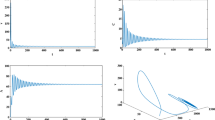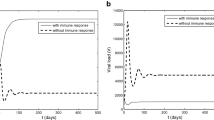Abstract
This study considers a mathematical model that describes the interaction between HIV, CD4+ T-cells and immune response of the body. The immune response activates with a time delay. A combined antiretroviral drug therapy is applied to control the progression of HIV to AIDS. Conditions are obtained for the existence and stability of uninfected and infected steady states. The delay in immune response contributes to alter the stability of steady states. More precisely, this time delay may not affect the local asymptotical stability of uninfected steady state, but can destabilize the infected steady state, which further leads to Hopf bifurcations. A critical delay has been identified to classify the significance of immune system of the body in changing the HIV infection dynamics. The direction of Hopf bifurcation and the stability of bifurcating periodic solutions are obtained using the center manifold theory. Numerical simulations are computed and exhibited to illustrate the effects of delayed immune response on the growth or decay of infection in the presence of combined drug therapy.








Similar content being viewed by others
References
Ciupe, M.S., Bivort, B.L., Bortz, D.M., Nelson, P.W.: Estimating kinetic parameters from HIV primary infection data through the eyes of three different mathematical models. Math. Biosci. 200, 1–27 (2006)
Culshaw, R.V., Ruan, S., Raymond, J.S.: Optimal HIV treatment by maximising immune response. J. Math. Biol. 48, 545–562 (2004)
Nowak, M.A., May, R.M.: Virus Dynamics. Oxford University Press, Oxford (2000)
Wodarz, D., Nowak, M.A.: Specific therapy regimes could lead to a long-term immunological control of HIV. Proc. Natl. Acad. Sci. 96, 14464–14469 (1999)
Zhu, H., Zou, X.: Dynamics of a HIV-1 infection model with cell-mediated immune response and intracellular delay. Discrete Contin. Dyn. Syst. Ser. B 12, 511–524 (2009)
Xie, Q., Huang, D., Zhang, S., Cao, J.: Analysis of a viral infection model with delayed immune response. Appl. Math. Model. 34, 2388–2395 (2010)
Zhu, H., Luo, Y., Chen, M.: Stability and hopf bifurcation of a HIV infection model with CTL-response delay. Comput. Math. Appl. 62, 3091–3102 (2011)
Song, X., Wang, S., Zhou, X.: Stability and hopf bifurcation for a viral infection model with delayed nonlytic immune response. J. Appl. Math. Comput. 33, 251–265 (2010)
Perelson, A.S., Kirschner, D.E., De Boer, R.: Dynamics of HIV Infection of CD4+ T-cells. Math. Biosci. 114, 81–125 (1993)
Perelson, A.S.: Modelling the interaction of the immune system with HIV. In: Castillo-Chavez, C. (ed.) Mathematical and Statistical Approaches to AIDS Epidemiology, p. 350. Springer, Berlin (1989)
Perelson, A.S., Nelson, P.W.: Mathematical Analysis of HIV-1 Dynamics in vivo. SIAM Rev. 41, 3–44 (1999)
De Leenheer, P., Smith, H.L.: Virus dynamics: a global analysis. SIAM J. Appl. Math. 63, 1313–1327 (2003)
Wang, L., Li, M.: Mathematical analysis of the global dynamics of a model for HIV infection of CD4+ T-cells. Math. Biosci. 200, 44–57 (2006)
Wodarz, D., Hamer, D.H.: Infection dynamic in HIV-specific CD4+ T-cells. Math. Biosci. 209, 14–29 (2007)
Perelson, A.S., Neumann, A.U., Markowitz, M., Leonard, J.M., Ho, D.D.: HIV-1 dynamics in vivo: virion clearance rate, infected cell life span, and viral generation time. Science 271, 1582–1586 (1996)
Mittler, J., Sulzer, B., Neumann, A., Perelson, A.S.: Influence of delayed virus production on viral dynamics in HIV-1 infected patients. Math. Biosci. 152, 143–163 (1998)
Callaway, D., Perelson, A.S.: HIV-1 infection and low steady state viral loads. Bull. Math. Biol. 64, 29–64 (2002)
Nelson, P.W., Murray, J.D., Perelson, A.S.: A model of HIV-1 pathogenesis that includes an intracellular delay. Math. Biosci. 163, 201–215 (2000)
Bonhoeffer, S., May, R.M., Shaw, G.M., Nowak, M.A.: Virus dynamics and drug therapy. Proc. Natl. Acad. Sci. USA 94, 6971–6976 (1997)
Dixit, N.M., Perelson, A.S.: Complex patterns of viral load decay under antiretroviral therapy: influence of pharmacokinetics and intracellular delay. J. Theor. Biol. 226, 95–109 (2004)
Nowak, M.A., Bonhoeffer, S., Shaw, G.M., May, R.M.: Anti-viral drug treatment: dynamics of resistance in free virus and infected cell populations. J. Theor. Biol. 184, 203–217 (1997)
Nelson, P., Mittler, J., Perelson, A.S.: Effect of drug efficacy and the eclipse phase of the viral life cycle on estimates of HIV-1 viral dynamic parameters. J. Acquir. Immune. Defic. Syndr. 26, 405–412 (2001)
Kirschner, D.E., Webb, G.F.: A mathematical model of combined drug therapy of HIV infection. J. Theor. Med. 1, 25–34 (1997)
Rong, L., Feng, Z., Perelson, A.S.: Mathematical analysis of age-structured HIV-1 dynamics with combination antiretroviral therapy. SIAM J. Appl. Math. 67, 731–756 (2007)
Mellors, J.W., Rinaldo, C.R., Gupta, P., White, R.M., Todd, J.A., Kingsley, L.A.: Prognosis in HIV-1 infection predicted by the quantity of virus in plasma. Science 272, 1167–1170 (1996)
Li, M.Y., Shu, H.Y.: Global dynamics of a mathematical model for HTLV-1 infection of CD4+ T cells with delayed CTL response. Nonlinear Anal. Real World Appl. 13, 1080–1092 (2012)
Pawelek, K.A., Liu, S., Pahlevani, F., Rong, L.: A model of HIV-1 infection with two time delays: mathematical analysis and comparision with patient data. Math. Biosci. 235, 98–109 (2012)
Srivastava, P.K., Banerjee, M., Chandra, P.: A primary infection model for HIV and immune response with two discrete time delays. Differ. Equ. Dyn. Syst. 18, 385–399 (2010)
Kamboj, D., Sharma, M.D.: Effects of combined drug therapy on HIV-1 infection dynamics. Int. J. Biomath. 09, 1–23 (2016)
Wang, Y., Zhou, Y., Wu, J., Heffernan, J.: Oscillatory viral dynamics in a delayed HIV pathogenesis model. Math. Biosci. 219, 104–112 (2009)
Wang, L., Ellermeyer, S.: HIV infection and CD4+ T-cell dynamics. Discrete Contin. Dyn. Syst. B6, 1417–1430 (2006)
Hale, J.: Theory of Functional Differential Equations, 2nd edn. Springer, New York (1977)
Yang, X., Chen, L., Chen, J.: Permanence and positive periodic solution for the single-species nonautonomous delay diffusive models. Comput. Math. Appl. 32, 109–116 (1996)
Freedman, H.I., Sree Hari Rao, V.: The trade off between mutual interference and time lags in predator-prey systems. Bull. Math. Biol. 45, 991–1004 (1983)
Hassard, B.D., Kazrinoff, N.D., Wan, W.H.: Theory and Application of Hopf Bifurcation, London Math Society Lect. Note Series, vol. 41. Cambridge University Press, Cambridge (1981)
Srivastava, P.K., Chandra, P.: Hopf bifurcation and periodic solutions in model for the dynamics of HIV and immune response. Differ. Equ. Dyn. Syst. 16, 77–100 (2008)
Author information
Authors and Affiliations
Corresponding author
Appendix A
Appendix A
Define a space of continuous real valued functions as \(C=C([-1,0],R^5)\). Let \(u_{1}(t)=T(t)-\overline{T}(t),\) \(u_{2}(t)=T_{1}(t)-\overline{T_{1}}(t)\), \(u_{3}(t)=T_{2}(t)-\overline{T_{2}}(t)\), \(u_{4}(t)=V(t)-\overline{V}(t)\) and \(u_{5}(t)=E(t)-\overline{E}(t)\). Define \(x_{i}(t)=u_{i}(\tau t)\) for \(i=1,2,3,4,5\), with \(\tau =\tau _{j}+\nu ,\) \(\nu \in R\), so that \(\nu =0\) is Hopf bifurcation value for the system. Then, the delay system (2.5)–(2.9) transforms to the functional differential equation in C as follows:
where \(x(t)=(x_{1}(t),x_{2}(t), x_{3}(t), x_{4}(t), x_{5}(t))^{T}\in R^{5}\), \(x_{t}(\theta )=x(t+\theta ),\) \(\theta \in [-1,0]\). \(L_{\nu }:C\rightarrow R^{5}\) and \(f:C \times R \rightarrow R^{5}\) are given by
and
where the matrices \(J_{1}=\mathbf J\) and \(J_{2}=\mathbf K\) are defined in Sect. 4.2. By the Reisz representation theorem, there exists a function \(\xi (\theta ,\nu )\) whose components are of bounded variation for \(\theta \in [-1,0]\) such that
In relation to the Eq. (7.2), we choose
where \(\overline{\delta }(\theta )\) is the Dirac delta function. Through the relevant expressions for function \(A(\nu )\) and \(R(\nu )\), the system (7.1) can be rewritten as
where \(x_{t}(\theta )=x(t+\theta )\) for \(\theta \in [-1,0]\). Let \(q(\theta )=(\alpha _{1},~ \alpha _{2},~\alpha _{3},~\alpha _{4}, ~\alpha _{5})^{T}e^{i\omega _{0}\tau _{j}\theta }\) be the eigenvector of A(0) (referred hereafter as A) corresponding to the eigenvalue \( i\omega _{0}\tau _{j}\) then
where, for \(\theta =0\), and \(\alpha _{1}=1\), we get \(\alpha _{2}=\frac{k\overline{V}-(i\omega _{0}+M)}{i\omega _{0}+\mu _{1}+(1-\eta )\alpha }\), \(\alpha _{3}=\frac{(i\omega _{0}+\mu _{v})\alpha _{4}}{N(1-\gamma )\delta }\), \(\alpha _{4}=\frac{(b+\eta \alpha )\alpha _{2}-(i\omega _{0}+M)}{k\overline{T}}\) and \(\alpha _{5}=\frac{pe^{-i\omega _{0}\tau _{j}}\alpha _{3}}{i\omega _{0}+d_{E}}\).
Similarly, assume \(q^{*}(s)=D(\alpha ^{*}_{1},~\alpha ^{*}_{2},~\alpha ^{*}_{3},~\alpha ^{*}_{4},~\alpha ^{*}_{5})^{T}e^{i\omega _{0}\tau _{j}s}\) to be the eigenvector of \(A^{*}\) (the adjoint of A) corresponding to the eigenvalue \(-i\omega _{0}\tau _{j}\), to get
with \(\alpha ^{*}_{1}=1\), \(\alpha ^{*}_{2}=\frac{-i\omega _{0}+M}{k\overline{V}}\), \(\alpha ^{*}_{3}=\frac{(-i\omega _{0}+\mu _{1}+\alpha +b)\alpha ^{*}_{2}-(b+\eta \alpha )}{(1-\eta )\alpha }\), \(\alpha ^{*}_{4}=\frac{k\overline{T}-k\overline{T}\alpha ^{*}_{2}}{i\omega _{0}-\mu _{v}}\), \(\alpha ^{*}_{5}=\frac{d_{x}\overline{T_{2}}\alpha ^{*}_{3}}{i\omega _{0}-d_{E}}\).
The normalization condition (i.e., \(\left\langle q^{*}(s),q(\theta )\right\rangle = 1)\) yields the value of \(\bar{D}\) as
where the inner product \(< ,>\) is defined as follows.
where \(\xi (\theta )=\xi (\theta ,0)\).
Following Hassard et al. [35], the coordinates are to be computed to describe the center manifold \(C_{0}\) at \(\nu =0\). Let \(x_{t}\) denotes the solution of Eq. (7.6) for \(\nu =0\). Define
On the center manifold \(C_{0}\), \(W(t,\theta )\) is expressed as
where z and \(\overline{z}\) are local coordinates for center manifold \(C_{0}\) in the direction of \(q^{*}\) and \(\overline{q^{*}}\). Considering only the real solution \(x_{t}\in C_{0}\) of the Eq. (7.6), we get
where
It follows from (7.11) and (7.12) that
so that for \(j=1,2,3,4,5\),
Now from (7.14),
The Eq. (7.17) is simplified and compared with (7.14) to get
\(W_{20}(\theta )\) and \(W_{11}(\theta )\), required to compute \(g_{21}\), are derived as follows:
Using the Eqs. (7.11) and (7.13), \(\dot{W}\) is written as
Using chain rule \(\dot{W}=W_{z}\dot{z}+W_{\overline{z}}\dot{\overline{z}}\), the Eqs. (7.13) and (7.23) yields
For \(\theta \in [-1,0)\), we have
which, on comparing the coefficients with (7.23), gives
From (7.24), (7.26) and the definition of A,
Noting \(q(\theta )=q(0)e^{i\omega _{0}\tau _{j}\theta },\) hence
Similarly, we have
where \(E_{1}=(E_{1}^{(1)}, E_{1}^{(2)},E_{1}^{(3)},E_{1}^{(4)},E_{1}^{(5)})\) and \(E_{2}=(E_{2}^{(1)}, E_{2}^{(2)},E_{2}^{(3)},E_{2}^{(4)},E_{2}^{(5)})\) \(\in R^{5}\) are constant vectors, to be determined. It follows from the definition of A and (7.24) that
and
Using (7.29) and (7.33) in (7.31) and noting that \(q(\theta )\) is eigenvector of A, we have
Similarly, using (7.30) and (7.34) in (7.32), we have
The systems (7.35) and (7.36) are solved for \(E_{1}\) and \(E_{2}\), respectively. Then, \(g_{21}\) is calculated from (7.21), through the expressions (7.29) for \(W_{20}\) and (7.30) for \(W_{11}\).
Rights and permissions
About this article
Cite this article
Kamboj, D., Sharma, M.D. Effect of Delayed Immune Response on the Dynamics of HIV Infection Under Multidrug Treatment. Differ Equ Dyn Syst 30, 61–84 (2022). https://doi.org/10.1007/s12591-018-0440-8
Published:
Issue Date:
DOI: https://doi.org/10.1007/s12591-018-0440-8




